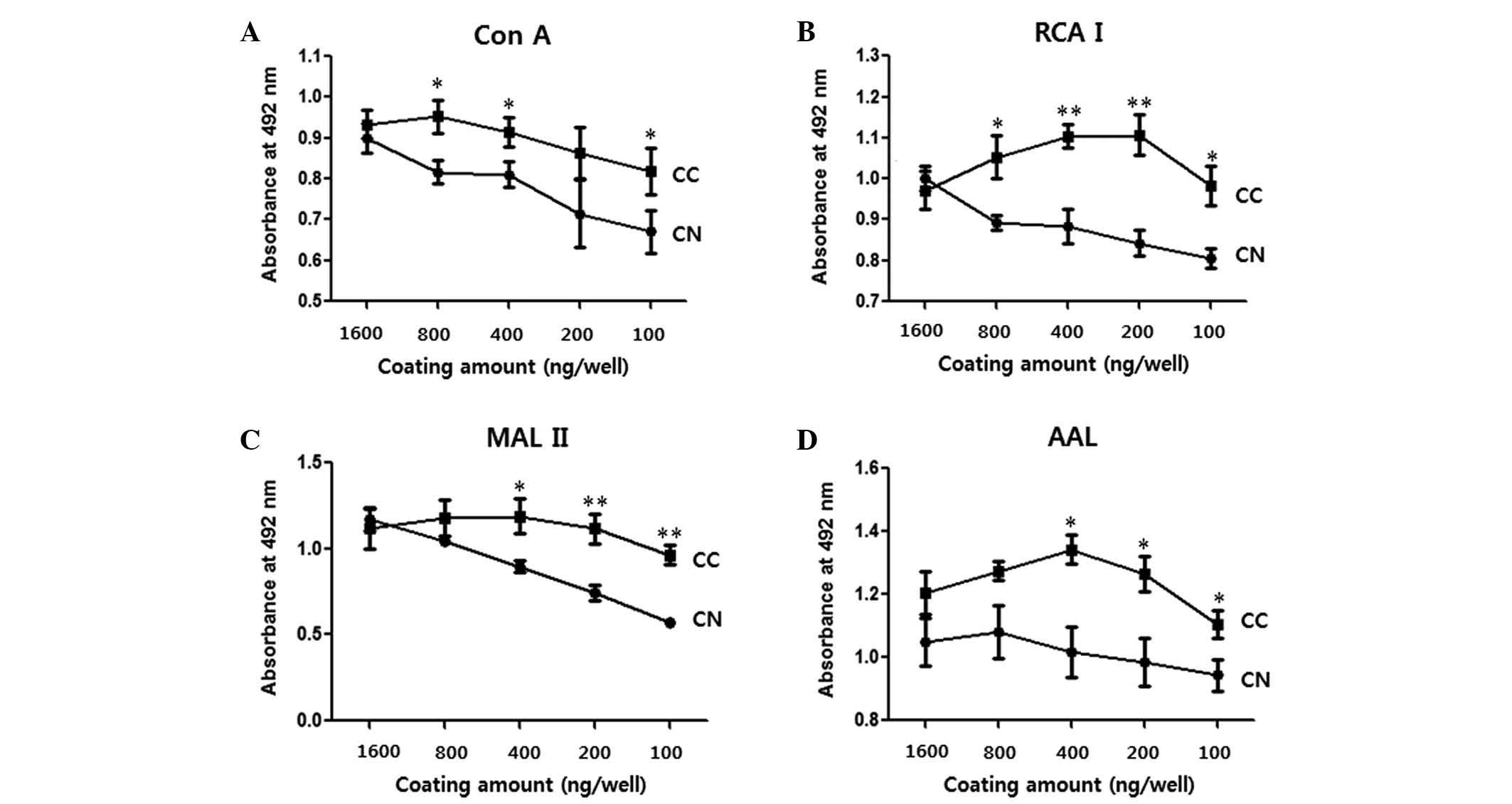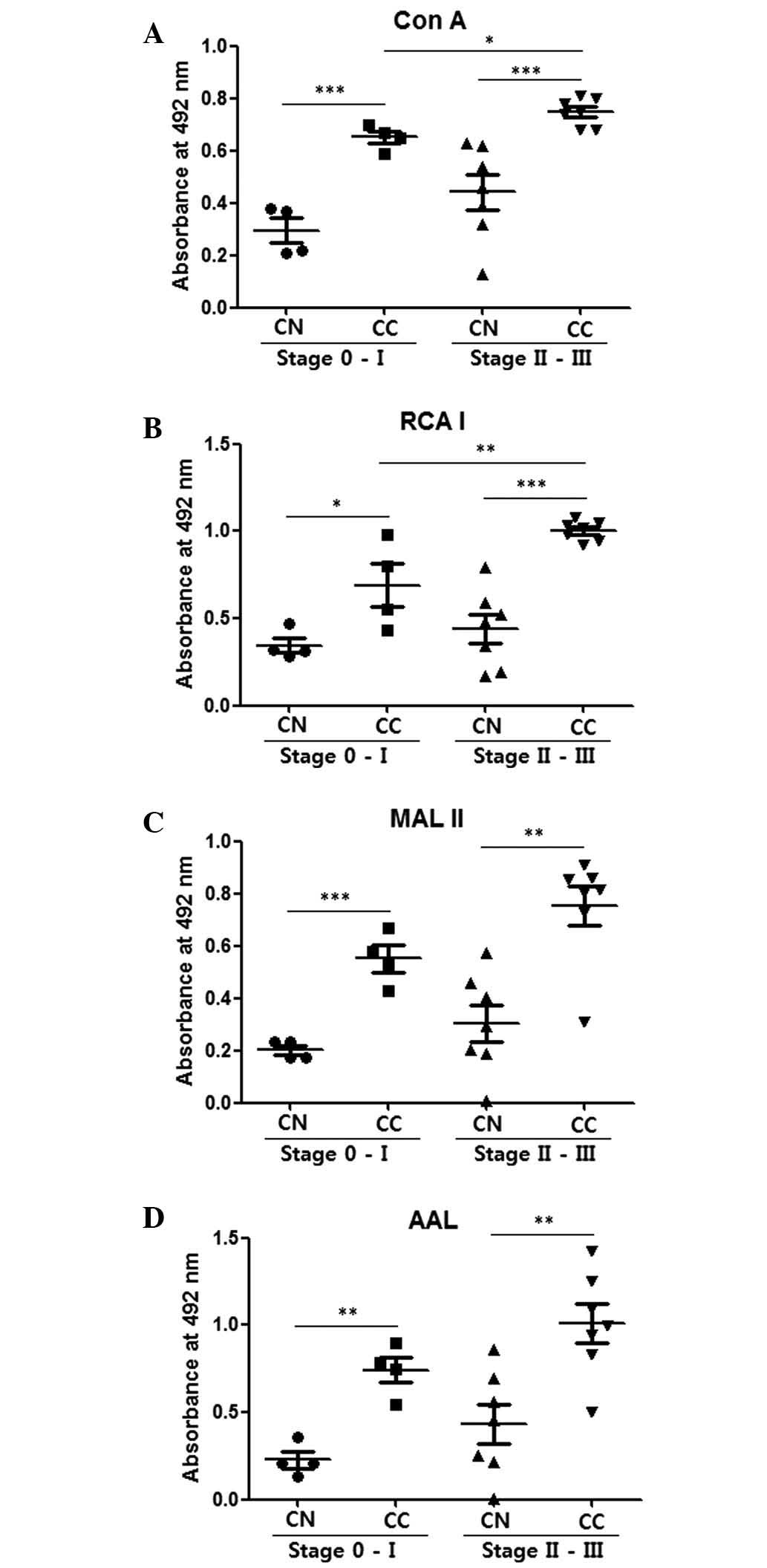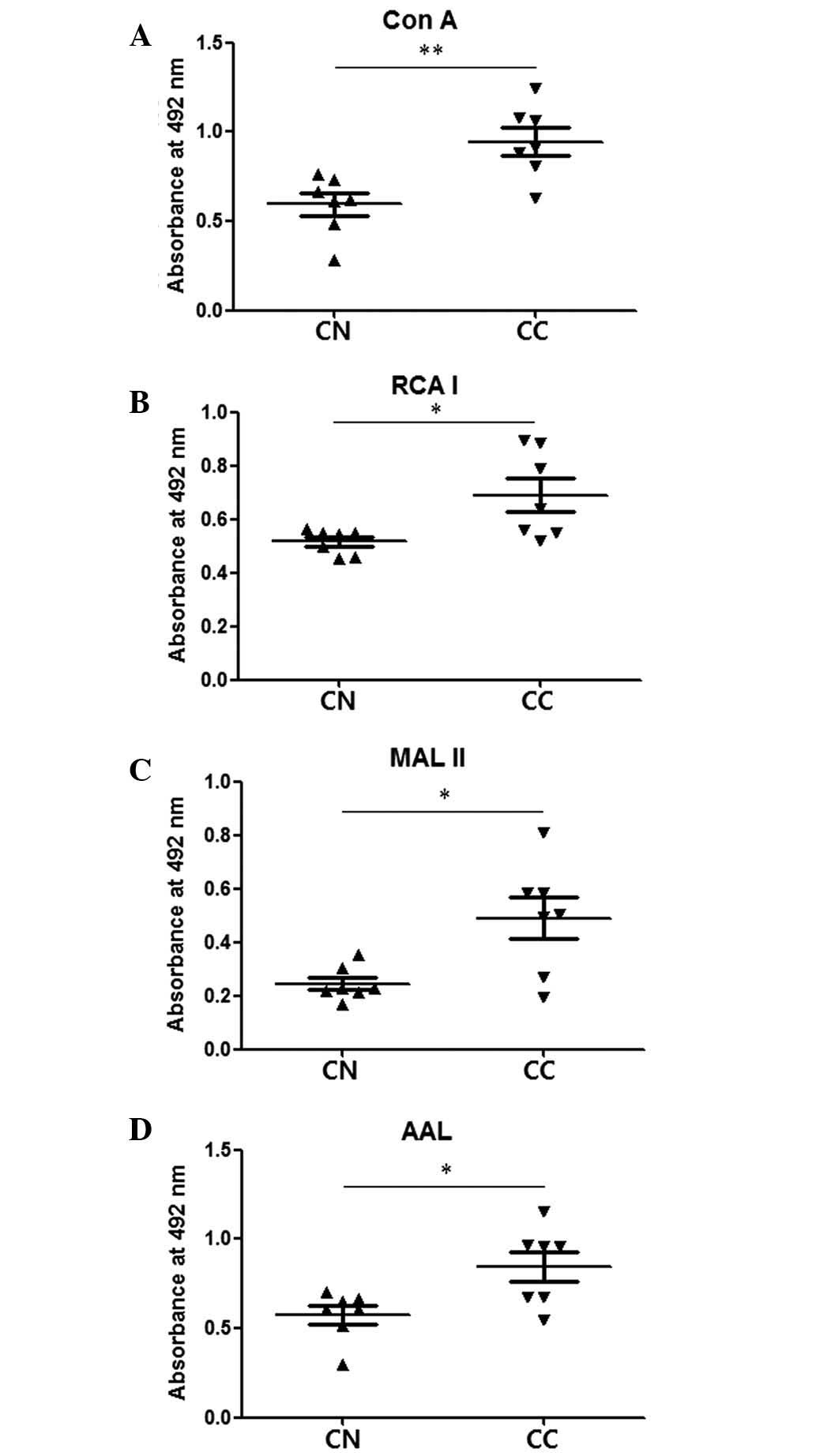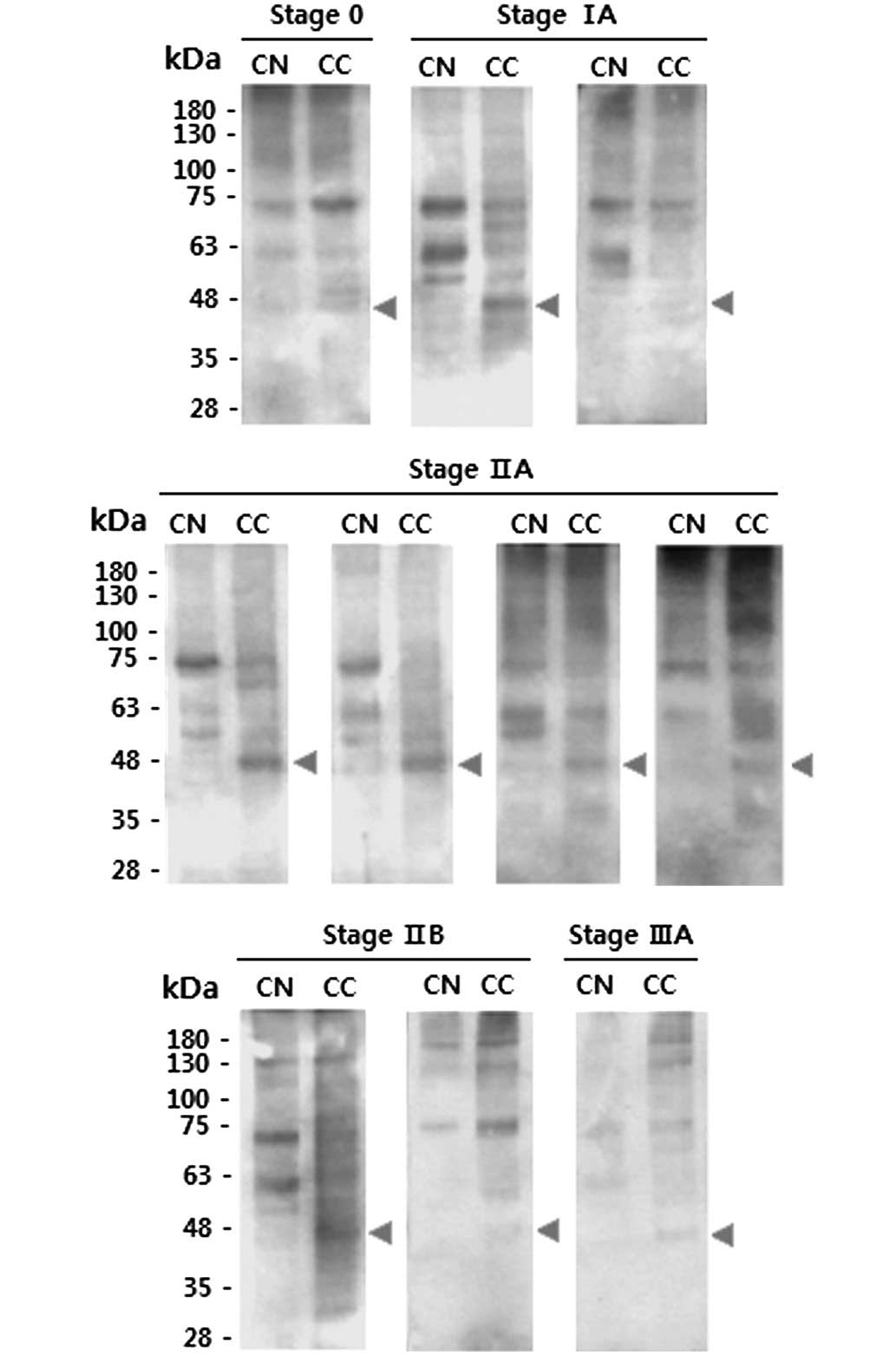|
1
|
Donepudi MS, Kondapalli K, Amos SJ and
Venkanteshan P: Breast cancer statistics and markers. J Cancer Res
Ther. 10:506–511. 2014.PubMed/NCBI
|
|
2
|
Cancer Genome Atlas Network: Comprehensive
molecular portraits of human breast tumours. Nature. 490:61–70.
2012. View Article : Google Scholar : PubMed/NCBI
|
|
3
|
Kolb TM, Lichy J and Newhouse JH:
Comparison of the performance of screening mammography, physical
examination and breast US and evaluation of factors that influence
them: An analysis of 27, 825 patient evaluations. Radiology.
225:165–175. 2002. View Article : Google Scholar : PubMed/NCBI
|
|
4
|
Alexander H, Stegner AL, Wagner-Mann C, Du
Bois GC, Alexander S and Sauter ER: Proteomic analysis to identify
breast cancer biomarkers in nipple aspirate fluid. Clin Cancer Res.
10:7500–7510. 2004. View Article : Google Scholar : PubMed/NCBI
|
|
5
|
Ahmed HG: Impact of implementing grading
fine needle aspiration cytology in diagnosis of breast cancer
amongst sudanese women. Oman Med J. 26:99–103. 2011. View Article : Google Scholar : PubMed/NCBI
|
|
6
|
Polyak K: Heterogeneity in breast cancer.
J Clin Invest. 121:3786–3788. 2011. View
Article : Google Scholar : PubMed/NCBI
|
|
7
|
Esteva FJ and Hortobagyi GN: Prognostic
molecular markers in early breast cancer. Breast Cancer Res.
6:109–118. 2004. View
Article : Google Scholar : PubMed/NCBI
|
|
8
|
Malhotra GK, Zhao X, Band H and Band V:
Histological, molecular and functional subtypes of breast cancers.
Cancer Biol Ther. 10:955–960. 2010. View Article : Google Scholar : PubMed/NCBI
|
|
9
|
Grunewald S, Matthijs G and Jaeken J:
Congenital disorders of glycosylation: A review. Pediatr Res.
52:618–624. 2002. View Article : Google Scholar : PubMed/NCBI
|
|
10
|
Li M, Song L and Qin X: Glycan changes:
Cancer metastasis and anti-cancer vaccines. J Biosci. 35:665–673.
2010. View Article : Google Scholar : PubMed/NCBI
|
|
11
|
Reis CA, Osorio H, Silva L, Gomes C and
David L: Alterations in glycosylation as biomarkers for cancer
detection. J Clin Pathol. 63:322–329. 2010. View Article : Google Scholar : PubMed/NCBI
|
|
12
|
Peracaula R, Barrabés S, Sarrats A, Rudd
PM and de Llorens R: Altered glycosylation in tumours focused to
cancer diagnosis. Dis Markers. 25:207–218. 2008. View Article : Google Scholar : PubMed/NCBI
|
|
13
|
van de Vijver MJ: Molecular tests as
prognostic factors in breast cancer. Virchows Arch. 464:283–291.
2014. View Article : Google Scholar : PubMed/NCBI
|
|
14
|
Hirabayashi J: Concept, strategy and
realization of lectin-based glycan profiling. J Biochem.
144:139–147. 2008. View Article : Google Scholar : PubMed/NCBI
|
|
15
|
Thompson R, Creavin A, O'Connell M,
O'Connor B and Clarke P: Optimization of the enzyme-linked lectin
assay for enhanced glycoprotein and glycoconjugate analysis. Anal
Biochem. 413:114–122. 2011. View Article : Google Scholar : PubMed/NCBI
|
|
16
|
Kim HJ, Lee SJ and Kim HJ: Antibody-based
enzyme-linked lectin assay (ABELLA) for the sialylated recombinant
human erythropoietin present in culture supernatant. J Pharm Biomed
Anal. 48:716–721. 2008. View Article : Google Scholar : PubMed/NCBI
|
|
17
|
Kim HJ, Lee DH, Kim DK, Han GB and Kim HJ:
The glycosylation and in vivo stability of human
granulocyte-macrophage colony-stimulating factor produced in rice
cells. Biol Pharm Bull. 31:290–294. 2008. View Article : Google Scholar : PubMed/NCBI
|
|
18
|
Kim HJ, Kim SC, Ju W, Kim YH, Yin SY and
Kim HJ: Aberrant sialylation and fucosylation of intracellular
proteins in cervical tissue are critical markers of cervical
carcinogenesis. Oncol Rep. 31:1417–1422. 2014.PubMed/NCBI
|
|
19
|
Harris JR: Natural history and staging of
breast cancer. Diseases of the Breast. Harris JR, Lippman ME,
Morrow M and Osborne CK: (1st). Lippincott-Raven. (Baltimore, PA).
457–459. 1996.
|
|
20
|
Chen GY, Chen CY, Chang MDT, Matsuura Y
and Hu YC: Concanavalin A affinity chromatography for efficient
baculovirus purification. Biotechnol Prog. 25:1669–1677.
2009.PubMed/NCBI
|
|
21
|
Clark D and Mao L: Cancer biomarker
discovery: Lectin-based strategies targeting glycoproteins. Dis
Markers. 33:1–10. 2012. View Article : Google Scholar : PubMed/NCBI
|
|
22
|
Hirabayashi J, Kuno A and Tateno H:
Lectin-based structural glycomics: A practical approach to complex
glycans. Electrophoresis. 32:1118–1128. 2011. View Article : Google Scholar : PubMed/NCBI
|
|
23
|
Renkonen J, Paavonen T and Renkonen R:
Endothelial and epithelial expression of sialyl Lewis(x) and sialyl
Lewis(a) in lesions of breast carcinoma. Int J Cancer. 74:296–300.
1997. View Article : Google Scholar : PubMed/NCBI
|
|
24
|
Imai J, Ghazizadeh M, Naito Z and Asano G:
Immunohistochemical expression of T, Tn and sialyl-Tn antigens and
clinical outcome in human breast carcinoma. Anticancer Res. 21(2B):
1327–1334. 2001.PubMed/NCBI
|
|
25
|
Jeschke U, Mylonas I, Shabani N,
Kunert-Keil C, Schindlbeck C, Gerber B and Friese K: Expression of
sialyl lewis X, sialyl Lewis A, E-cadherin and cathepsin-D in human
breast cancer: Immunohistochemical analysis in mammary carcinoma in
situ, invasive carcinomas and their lymph node metastasis.
Anticancer Res. 25(3A): 1615–1622. 2005.PubMed/NCBI
|
|
26
|
Christiansen MN, Chik J, Lee L, Anugraham
M, Abrahams JL and Packer NH: Cell surface protein glycosylation in
cancer. Proteomics. 14:525–546. 2014. View Article : Google Scholar : PubMed/NCBI
|
|
27
|
Häuselmann I and Borsig L: Altered
tumor-cell glycosylation promotes metastasis. Front Oncol.
4:282014. View Article : Google Scholar : PubMed/NCBI
|
|
28
|
Miyoshi E, Moriwaki K, Terao N, Tan CC,
Terao M, Nakagawa T, Matsumoto H, Shinzaki S and Kamada Y:
Fucosylation is a promising target for cancer diagnosis and
therapy. Biomolecules. 2:34–45. 2012. View Article : Google Scholar : PubMed/NCBI
|
|
29
|
Van Elssen CH, Frings PW, Bot FJ, Van de
Vijver KK, Huls MB, Meek B, Hupperets P, Germeraad WT and Bos GM:
Expression of aberrantly glycosylated Mucin-1 in ovarian cancer.
Histopathology. 57:597–606. 2010. View Article : Google Scholar : PubMed/NCBI
|
|
30
|
Liu H, Zhang N, Wan D, Cui M, Liu Z and
Liu S: Mass spectrometry-based analysis of glycoproteins and its
clinical applications in cancer biomarker discovery. Clin
Proteomics. 11:142014. View Article : Google Scholar : PubMed/NCBI
|
|
31
|
Holst S, Stavenhagen K, Balog CI, Koeleman
CA, McDonnell LM, Mayboroda OA, Verhoeven A, Mesker WE, Tollenaar
RA, Deelder AM and Wuhrer M: Investigations on aberrant
glycosylation of glycosphingolipids in colorectal cancer tissues
using liquid chromatography and matrix-assisted laser desorption
time-of-flight mass spectrometry (MALDI-TOF-MS). Mol Cell
Proteomics. 12:3081–3093. 2013. View Article : Google Scholar : PubMed/NCBI
|
|
32
|
de Leoz ML, Young LJ, An HJ, Kronewitter
SR, Kim J, Miyamoto S, Borowsky AD, Chew HK and Lebrilla CB:
High-mannose glycans are elevated during breast cancer progression.
Mol Cell Proteomics. 10:M110.0027172011. View Article : Google Scholar : PubMed/NCBI
|
|
33
|
Weedon-Fekjaer H, Romundstad PR and Vatten
LJ: Modern mammography screening and breast cancer mortality:
Population study. BMJ. 348:g37012014. View Article : Google Scholar : PubMed/NCBI
|
|
34
|
Papanicolaou GN, Holmquist DG, Bader GM
and Falk EA: Exioliative cytology of the human mammary gland and
its value in the diagnosis of cancer and other diseases of the
breast. Cancer. 11:377–409. 1958. View Article : Google Scholar : PubMed/NCBI
|
|
35
|
Harigopal M and Chhieng DC: Breast
cytology: Current issues and future directions. The Open Breast
Cancer Journal. 2:81–89. 2010.
|














